Covid in Wales: What do the stats tell us?
 Getty Images
Getty ImagesWhat can statistics tell us about coronavirus in Wales?
Here we assess some of the figures showing the pandemic over its peak years and also give some of the remaining indicators as they stood in May 2024.
The World Health Organization (WHO) declared in May 2023 that Covid-19 was no longer a global health emergency, but said it did not mean the danger was over.
In Wales, while some hospital and mortality data was still being published in autumn 2024, other surveillance measures had been scaled back or discontinued.


What did indicators show by the end of summer 2024?
There was a peak in people testing positive for Covid in hospitals in late January 2024 and numbers then settled into a pattern of rising and falling.
Other indicators around waste water monitoring and people contacting their GPs last winter showed lower levels than the same period the year before.
Mortality figures involving Covid in the eight months to the end of August 2024 were about 60% of the total we saw in the same period of 2023 - about 13 deaths a week compared with 22 deaths a week.

Digital Health and Care Wales stopped its weekly Covid snapshot figures in the summer of 2023, although Public Health Wales (PHW) was still publishing some hospital and testing data in autumn 2024.
Positive tests for Covid appear to follow a more cyclical pattern than flu or other winter viruses, which show a seasonal peak.
Numbers of inpatients with Covid started to drop again by early February 2024 but followed a rising and falling pattern in the next few months.
There were 192 in-patients testing positive for Covid, including 15 patients in critical care in the week ending 8 September.
We might expect to see more elderly people in hospital and around half of those testing positive for Covid were over 80 and 89% were over 60.
We no longer know how many of these patients are being treated primarily for Covid or happen to be incidentally testing positive while in hospital for other things.

PHW was still publishing weekly data on patients who test positive for Covid in hospitals - and where they were likely to have acquired it.
There were 91 positive tests for Covid in hospitals in the week ending 8 September.
Figures showed "probably" or "definitely" hospital-acquired infections in patients made up 59% of those with Covid in beds, compared with those patients who came with Covid or the origin cannot be determined.
Hospital-acquired infections stood at 54.
There have been nearly 25,000 hospital-acquired infections recorded since the start of the pandemic.
The issue of patients catching Covid while in hospital was a particularly acute feature during the early days of the pandemic, when there was no vaccine.
The pattern of acute respiratory infections over the past two winters suggest seasonal peaks for flu and respiratory syncytial virus (RSV).
But Covid infections among those in hospital show more of an undulating pattern over the course of the year.
The peaks were not as high in the winter of 2023-24 as they were in the previous winter.
RSV had started to rise amongst mostly young children to very high intensity levels but dropped back.
Flu cases in the community rose in early February but only to low intensity before falling back.
Patients testing positive for flu in hospital fell from mid-February.
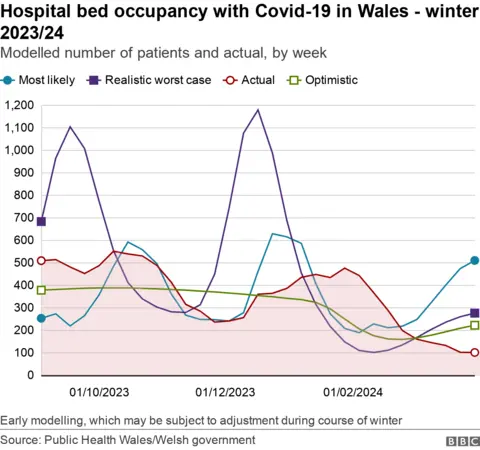
Covid over the winter
Health officials kept a close eye on Covid over the winter period in 2023-24, in case it added to pressures on the NHS with more seasonal viruses.
This winter, there was a realistic worst scenario of just under 1,200 Covid patients in late December and a "most likely" of 620 patients in the early modelling from Welsh government scientists.
The actual figures in late December were close to the optimistic scenario - 380 patients - but moved closer to the worst-case scenario at the end of the first week of 2024.
For about half the winter period, the actual number of patients testing positive for Covid was greater than the most likely scenario.
By the end of March, it was below the most likely and optimistic scenarios.
In winter 2022-23, the peak when it came in late December reached about 650 patients, three weeks after the modelled peak for a reasonable worst scenario of 1,800 patients.
The actual curve for patients with Covid positive tests by the end of the modelling period in March 2023 was tracking with the "most likely" scenario after following a more undulating pattern, which had taken it closer to the "optimistic" scenario at one point.
Another snapshot of how Covid and other viruses are present is sample tests from up to 1,500 patients attending hospital each week.
These tests are for a range of respiratory viruses and showed around 13% testing positive for Covid at the winter peak in mid-January and 16% for flu when it peaked in early February.
By the end of June, fewer than 2% were testing for flu but 18% were for Covid on these random tests - the highest proportion since the previous October.
This is separate from testing for Covid or flu only or those showing symptoms.
What do other indicators tell us?

The rate at which GPs are consulted about Covid-19 is also another indicator, which peaked in the first week of January 2022 at 98 consultations per 100,000 and had fallen back to extremely low levels, around one or two per 100,000 in the first quarter of 2024.

Another measure had been analysing samples of waste water, which was re-started for the winter of 2023/24.
Early results showed samples indicating presence of Covid were not close to to the levels seen in the autumn and winter of 2022-23, reflecting indicators elsewhere.
Surveillance involving testing for infection of blood donors was also stopped at the same time.
Wales did not join a scaled-down relaunch of the long-running ONS swab survey, which had been discontinued in early 2023.


How many people have died from Covid-19?
The number of people who have died with Covid as a contributory factor had reached 12,902 in Wales by the end of August 2024.
Deaths in 2023 ran at around half the number we saw in 2022.
In the most recent week, up 30 August, 10 people in Wales had a death registered which involved Covid-19 and saw it mentioned on their death certificate, according to the ONS.
Six of these deaths had Covid as the underlying cause of death.


Up to 30 August 2024, there had been around 10,476 deaths due to Covid, with the virus the underlying cause of death.
- The first death in Wales from Covid occurred on 15 March 2020 in a 68-year-old Wrexham hospital patient
- The first wave peaked with 73 deaths on a single day in April 2020
- Covid's second wave in the winter of 2020-21 brought 83 deaths on 11 January 2021 alone - the worst single day of the pandemic in Wales
- The pattern for deaths remained fairly low in 2022, although the summer heatwave brought a peak of 27 deaths between 18-19 July 2022
- Winter 2022-23 brought a peak of 17 deaths on 10 January 2023, the most occurring in a single day for a year. The whole of 2023 brought just over 1,000 deaths with Covid a factor.
- Covid was the ninth leading cause of death in 2023 up to the end of July.
- There were an average of 15 deaths a week due to Covid in 2023, and this compared with an average of 100 a week during the main pandemic period in 2020. It had dropped again to nine deaths a week in the first eight months of 2024.

ONS also now records so-called "expected deaths". This is a change from a previous "excess deaths " approach, which looked at an average for deaths from all causes across five non-pandemic years.
This now adjusts for population changes and age trends and so it has revised down estimates we saw under the previous method.
So between January 2020 and August 2024, there had been around 7,000 more deaths than we might have expected to see.
During 2020, there were around 3,216 more deaths than expected - compared to around 3,500 when measured as "excess deaths".
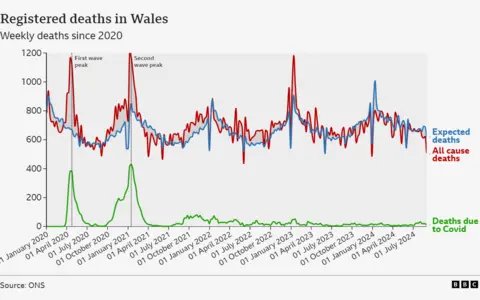

Over the eight months to late August 2024, deaths have been running below expected levels in all but 12 weeks.
There were 508 deaths from all causes - 108 fewer than we might expect to see in week ending 30 August2024.
Covid accounted for 1.3% of all deaths in Wales in the first eight months of 2024.
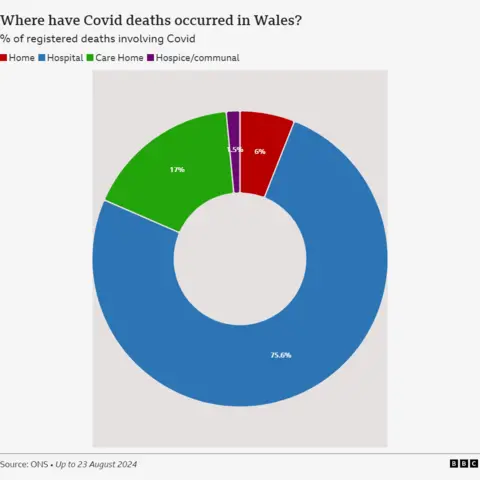

Nearly a fifth (17%) of all Covid deaths registered have occurred in care homes.
The first occurred in Blaenau Gwent and Caerphilly in the last week of March 2020 and eventually totalled around 1,650 Covid deaths in the first two waves of the pandemic.
There were 16 deaths involving Covid among care home residents registered between January and late August 2024.
Care Inspectorate Wales reported that deaths peaked in May 2020 and before it stopped publishing data it was notified of 2,339 care home resident deaths with suspected or confirmed Covid up to the end of June 2023.

There were 726 deaths above the five-year average in care homes in Wales in April 2020, at the height of the first wave of the pandemic.
There were also high numbers of excess deaths in the winter of 2020-21, when the vaccination programme was only just starting.
Altogether, in the three-year period from January 2020 there were nearly 1,500 excess deaths in care homes in Wales.
ONS analysis of deaths in care homes in 2021 found mortality rates lower in Wales in male residents than in England or any English region. The same occurred in 2022.
The two peaks for Covid deaths in care homes came in weeks in April 2020 (125 deaths) and January 2021 (129 deaths).
Covid was the second leading cause of death in care home residents after dementia in 2021, accounting for 12.9% of male resident deaths and 11.1% of female resident deaths.
In 2022, Covid dropped to being the fifth leading cause of death in care home residents in 2022, accounting for 4.5% of deaths.
Meanwhile, up to the end of February 2022, 120 people working in health and social care in Wales had died, with Covid a factor. Of these, 62 were care workers and 58 worked for the health service.
How do deaths from Covid-19 compare with other causes, like flu?
There were nearly twice as many deaths due to flu and pneumonia in Wales than due to Covid in 2023.
There have been more Covid than flu deaths in only three weeks over the last year and four times as many flu deaths than Covid deaths in 2024 up to the start of May.
Covid-19 was the 32nd leading cause of death in Wales in July 2023, after being the 19th leading cause in June.
This was the lowest ranking as cause of death for two years and the third lowest since the pandemic began. It was behind accidental poisoning and appendicitis.
Monthly mortality analysis - which was also discontinued at the end of July - showed there were 21 deaths due to Covid in July 2023 - 0.8% of all registered deaths.
Looking at when Covid was a contributory factor, there were 29 deaths involving Covid in Wales - or 1.1% of all deaths registered in July.

Heart disease was again the leading cause of death in July 2023 in Wales.
Flu and pneumonia again ranked sixth but below normal levels.

Covid was the leading cause of death at the height of the pandemic in 2020 and then the second leading cause of death in Wales after heart disease in 2021.
It was the seventh leading cause of death in 2022, with a mortality rate of 38.5 deaths per 100,000.
It was then the eighth leading cause of death for 2023 in Wales, with a mortality rate of 23.3 deaths per 100,000.
Across England and Wales in the whole of 2023, deaths due to Covid were 2% of all cause deaths. This compared to 4.2% from flu and pneumonia
Heart disease ranked as the leading cause of death for 2022 and in England and Wales it was dementia and Alzheimer's disease in 2023, closely followed by heart disease.

What age were people dying of Covid?
- The median age of a person to die due to Covid during the pandemic has been 82.
- Three children aged one to 14 have died where Covid has been a factor.
- A baby girl is so far the only child under one to have died where Covid was a factor, in the week ending 18 November 2022.
- In the first wave of the pandemic in 2020, 68% of Covid deaths in Wales were estimated to involve people who considered themselves to have some form of disability
- Around 73% of deaths involving Covid were in the over 75s and the median age of death due to Covid in June 2023 was 83.
- There has been one death in Wales, in October 2022, where Covid vaccination has been a factor, according to death registrations. It involved a person in their 50s.
- There were seven deaths involving Covid in the age group 15 to 44 in 2023.

Analysis of mortality from the start of the pandemic until the end of July 2023 shows the age-standardised mortality rate for deaths involving Covid is slightly higher in Wales (102.2 deaths per 100,000), than England on 101.5 deaths per 100,000.
Scotland (9.56) and Northern Ireland (93.2) are both lower in the 41 months to the end of July.
The age-standardised mortality rate due to Covid - with Covid the underlying cause of death - is slightly higher in England than in Wales.
It is also higher in all English regions apart from south west, south east and east England.
When a crude mortality rate, not adjusting for the age or population profile, is used, deaths are higher in Wales.

Are deaths really 'due to' Covid-19?
Covid was the underlying cause of death - not just a contributory factor - in 70% of Covid deaths mentioned by doctors on death certificate in Wales in 2023.
It has been as high as 94% and on average since the outbreak of the pandemic until the end of August 2024, 82% of deaths with Covid on death certificates could be said to be due to Covid.
So, there had been around 10,429 deaths due to Covid by 30 August 2024 in Wales.
Covid has been "suspected" by doctors in around 4% of cases.
A doctor's duties include certifying deaths, and this can include any cause in a chain of events leading up to them, including pre-existing conditions and whatever medically makes a contribution.
Which areas have been hit hardest?
Rhondda Cynon Taf (RCT) and Merthyr Tydfil had the highest crude mortality rates over the course of the pandemic in Wales.
By 29 December 2023, RCT had reached a total of 1,235 deaths, with the highest crude mortality rate - 516.7 deaths per 100,000.
This was the seventh highest crude mortality rate of all local authorities across England and Wales.
Deaths involving Covid can also be shown to be hitting people living in deprived areas, usually associated with poorer health, harder than in the least deprived areas of Wales.
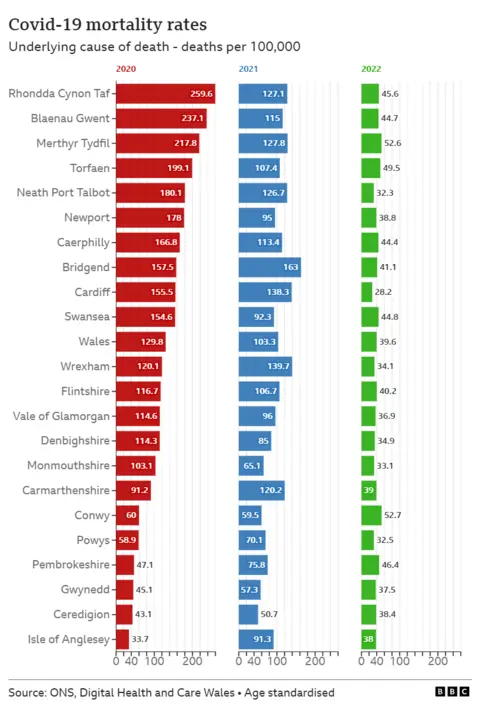

When deaths from Covid as the underlying cause and adjusted for age are looked at, then Rhondda Cynon Taf, Blaenau Gwent and Merthyr had the highest mortality rates in 2020.
Bridgend had the highest Covid mortality rate in 2021, including the peak of the pandemic's second wave.
Conwy had a relatively higher mortality rate in the third year of the pandemic.
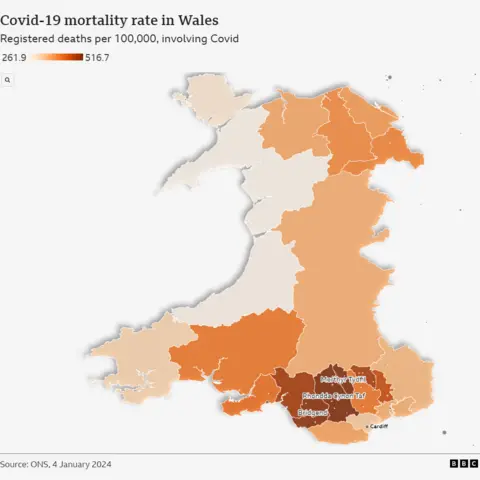
Six of RCT's communities were in the highest 20 within Wales during the first and second waves, when the death rates can be broken down further.
At a health board level, the age-standardised mortality rate for Cwm Taf Morgannwg, which covers RCT, Merthyr and Bridgend, was 127 deaths per 100,000 due to Covid in the three years of the pandemic up to the end of July 2023.
This is the highest in Wales, the lowest being 55.5 deaths per 100,000 due to Covid in the Powys health board area, set against a Welsh average of 84.3.
For 2023, Conwy, Bridgend and Powys had the highest Covid mortality rates in Wales, based on the sizes of their populations.
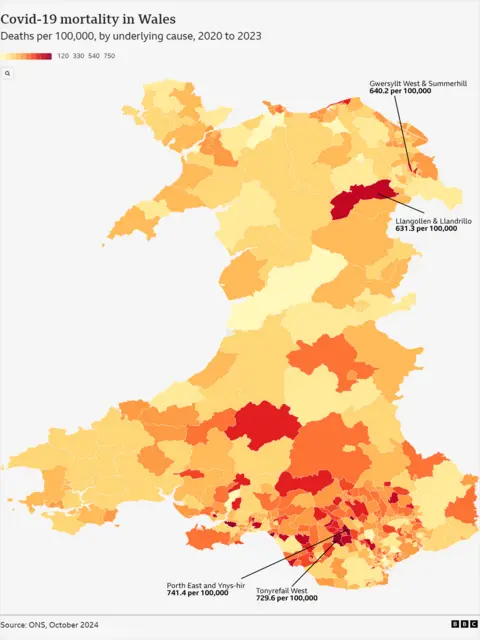

The community with the highest number of Covid deaths across 2020 and 2021, including in the first two waves of the pandemic, was Tonyrefail West (RCT) with a total of 63 deaths due to Covid. In the period to include 2023, this rose to 75 deaths.
Nearby Porth East and Ynys-hir had the highest mortality rate due to Covid, 2020 to 2023, with more than 741 deaths per 100,000.
The lowest number of deaths at a community level during the main pandemic years were in Aberystwyth North and Aberystwyth South, Bangor City and Llandudno Junction South and Llansanffraid Glan Conwy.
At a local authority level, in the second wave of the pandemic, Bridgend was the worst-hit area in Wales.
In 2021, Bridgend had the highest Covid mortality rate - 271 deaths or 183.2 deaths per 100,000; this was the 24th highest area across England and Wales.

'Unexplained' Covid mortality clusters
The first wave of the pandemic brought early clusters of deaths in the old Gwent valleys, around Pontnewydd and Upper Cwmbran, Cross Keys and Ebbw Vale, followed by Tonyrefail East in Rhondda Cynon Taf. Blaenau Ffestiniog and Llanberis in Gwynedd also had early clusters in north Wales, according to data analysis.
These were adjusted for age or deprivation and so other factors such as travel patterns or occupations may have come into play to explain the spread of infection.
The highest rate by the end of March - a few days after lockdown - was around Caerphilly and the valleys to the north and was more than 11 times what would be expected compared with the whole of Wales.
By mid-April, higher mortality rates had spread to Welsh border counties and expanded into Cardiff and Swansea and other valleys areas.
By the end of the first wave, the only clusters of higher mortality were showing in parts of north Wales.
ONS said there was higher mortality in more deprived areas of south east Wales, but consistently high mortality was also seen in some rural areas after accounting for known risk factors.
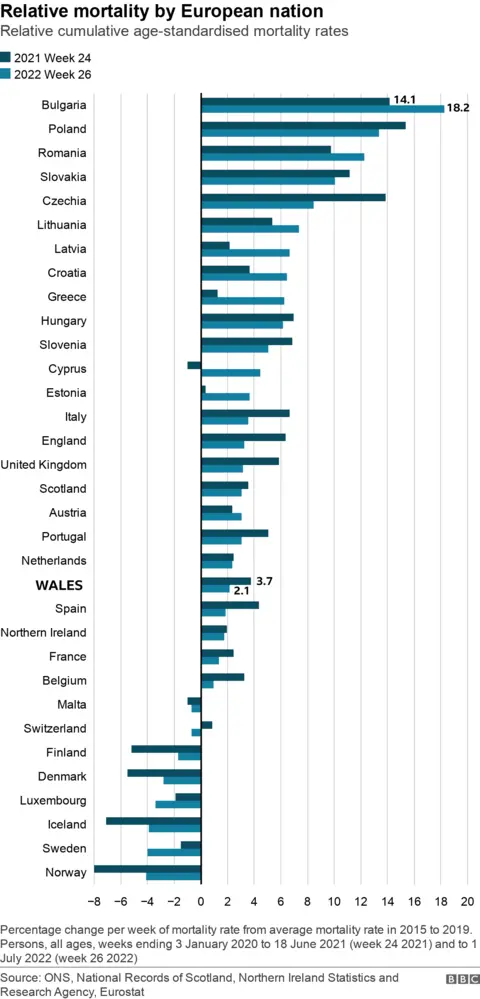
How does Wales compare with other countries?
There are figures to compare relative excess deaths in different European countries.
Bulgaria has the highest relative cumulative age-standardised mortality rate - 18.2% higher than normal - and Norway the lowest, 4.1% below average.
Wales was 3.7% above average in June 2021 and then 2.1% above average in July 2022 - ranked 21st out of 33 nations.
For those aged under 65, Wales was 4.8% above average (ranked 12th) and 1.5% above average (joint 24th) in the over-65s.
Wales also saw excess mortality in more than half of weeks over the period.

Vaccination programme passes 10m doses
Covid vaccinations passed the 10m mark as the spring 2024 booster programme progressed in April 2024.
The autumn-winter booster programme reached more than 742,500 people in 2023-24.
That included nearly three quarters of over 65s and 85% of care home residents.
Numbers of NHS staff who took up offers of a vaccine booster was down on earlier stages of the programme.
Just over half of all those eligible across different groups had taken up the offer, perhaps reflecting numbers who felt they had immunity from having had the virus more than once.
The 2024 spring programme - targeting mainly the over 75s - reached 147,481 doses by early May.
Analysis of vaccine uptake has consistently found gaps between people living in deprived areas and also people from black, Asian and mixed groups.
The offers of the primary course of vaccine to anyone over five, available since December 2020, ended in June 2023.
What about variants?
The dominant variant in Wales has been Omicron for more than two years and 357 positive test results had been sequenced in the month ending 21 May 2024.
Because of the ending of mass testing in April 2022, we should not expect to see the same numbers of results going off for sequencing any more.
Nearly all of those analysed in the last month have been the JN.1 sub-variant.
Infections peaked in April 2022
From summer 2020, the ONS organised a weekly nose and throat swab survey involving thousands of households across Wales, which latterly saw people being sent test kits by post.
It became the most important tool to measure the level of infections, with the end of mass testing in March 2022.
By this measure, infections were estimated to have peaked in Wales in April 2022 with 232,000 (around 8%) estimated to be affected.
However, the survey was "paused" at the end of March 2023, as the UK Health Security Agency (UKHSA) worked to confirm a surveillance approach which was "proportionate and cost effective" to living with Covid.
The health minister expressed her "deep disappointment and concern" about the "loss of this important source of surveillance". and the break in data gathering at a time infections were still being recorded in Wales.
But the Welsh government decided not to re-join a scaled-down version of the survey, which was relaunched in winter 2023, testing around 29,000 people.
This suggested 2.7% of people in England and Scotland had Covid in the week ending 3 January 2024.

Data from the infection survey, before it was wound up, also suggested 94.6% of adults in Wales have some protection from antibodies - through vaccination or immunity following infection.
The estimate was 91% of 16 to 24-year-olds in Wales would have tested positive for antibodies in February 2023.
At the higher threshold, 79.5% of adults in Wales are at or above 800 nanograms per millilitre and nearly three quarters in those aged 16 to 24 and 92.3% of the 75-79 age group.
A test of blood donors in Wales found more than 80% prevalence of the N antibody, indicating a natural infection from having Covid, and a 99.9% prevalence of the S antibody from either infection or having had the Covid vaccine.

Around 94,000 reported long Covid symptoms
The number of people who were reporting they had long Covid symptoms in Wales a year after being infected in early March 2023 was estimated to be around 57,000.
This was just under 2% of the population who are estimated to still be suffering symptoms 12 months or more since having Covid.
A total of 94,000 people were estimated to have long Covid at any duration. Of these, 24% said it had "a lot" of impact on their daily lives and 52% said it had little impact.
An estimated 3.14% of people in Wales reported having long Covid - this was slightly less than in Scotland and the West Midlands and north west and north east of England.
Just under 2% reported long Covid after a year - fewer than England and most of its regions and Scotland.
Two thirds in Wales reporting long Covid said they had symptoms of weakness and tiredness and more than half a shortness of breath.
Nearly half had muscle ache.
This data set has now been curtailed, with the end of the ONS infection survey.
A separate survey of more than 1,600 people with long Covid in Wales referred to the Adferiad recovery programme found around 70% were female and half were aged over 50.
Of those needing follow-up, around a quarter had hospital treatment. Average stays were around two weeks.
Fatigue, "brain fog" and shortness of breath were the most common symptoms.
Scientific advisers for the Welsh government estimate that potentially up to a quarter of people who have Covid may develop long Covid.
In January 2022, this would have included far higher proportions of Covid cases involving people aged between 50 and 70 - an estimated 43% of those with Covid.
But even if 6% of young people under 25 with Covid developed long-term symptoms, this could still mean more than 2,200 young people with long Covid in Wales.
This analysis was used to develop a "social cost" estimate for Covid, which looked at the cost to the NHS of treating Covid at different stages of the pandemic.
With the effects of the vaccine, and less patient time in hospital and intensive care, it meant this estimated cost had fallen from £21,000 per case in the second wave of the pandemic to £5,769 per case by January 2022.
Of this, more than £4,800 per case would be the cost of long Covid.

Hospitals during the peaks of the pandemic
The first Welsh patient to be admitted to a hospital with Covid was on 2 March 2020.
Waves of the pandemic saw dozens of patients in critical care with Covid.
This reached 164 patients at the first wave peak in April 2020, while the second wave peak in January peaked at 150 patients.
As the vaccination programme kicked in, there were only 40 patients at the winter peak of 2021-22 and then 24 patients with Covid in critical care at the peak of winter 2022-23.
For the final Digital Health and Care Wales figures, there were five patients in critical care with Covid on 12 July 2023, with one of those recovering from Covid.
A long-running study of more than 500 Welsh critical care patients with Covid gave insights into the virus.
The mortality rate was about 34%, including those who died later on a general ward.
About 63% had been discharged from hospital. The study also showed patients admitted in the past year who survived were spending less time in critical care - an average of seven days - than early in the pandemic.
Around 60% of patients had been admitted to critical care with Covid the primary reason for treatment.
The average age of those admitted in 2022-23 was 58, and just over half were men. Half were from more deprived parts of Wales. About 26% were under 50.

At its peaks, there were between 120 and 140 admissions a day on average to hospitals for patients with Covid.
By the time Digital Health and Care Wales halted their data gathering, there were five admissions of people testing positive for Covid on 12 July 2023, with numbers in single figures for the previous three months.
Figures had been low and, for the first time since the pandemic began, no Covid admissions were recorded on 24 January 2023. The previous low had been just one admission on two days in May and June 2022.

How many Covid hospital cases were directly due to the virus?
Over 18 months from the start of 2022, hospitals in Wales were asked to track how many of their patients testing positively for Covid were actually being primarily treated for it.
Over this period, 13% of patients on average with Covid were being actively or primarily treated for it.
There were some differences between health boards over definitions so care needs to be taken in how we interpret this.
But since the autumn of 2022, the proportion of "active" Covid cases was usually in single figures.
The Icnarc intensive care study has found a far smaller proportion of critical care patients with Covid were being primarily treated for the virus during 2022 (41%), compared with the period before (nearly 86%).
The mortality rate was 31% for those with "primary" Covid, compared with 25% for those with incidental Covid.


What case rates told us about Covid in Wales
- After the end of mass testing at the end of March 2022, there was no longer a reliable case rate based on PCR test results
- Up to 1 April 2022, there were 827,225 positive cases across Wales, but this only measured people who were tested. It did not include many people not offered a test in the first wave, those who chose not to be tested, as well as thousands testing positive with lateral flow tests in 2022
- Over the course of the mass testing period in the pandemic, Merthyr Tydfil had the highest cases per 100,000 of Wales' local authorities.
- The biggest spike in cases came with the Omicron variant in early 2022 - by which stage, nearly three quarters of people had received two doses of the vaccine
- Only around 33,730 positive PCR tests were recorded in the year after mass testing ended. Only around 100 positive PCR tests were being recorded weekly by April 2024.
- There were nearly 14,000 positive PCR tests recorded in 2023.
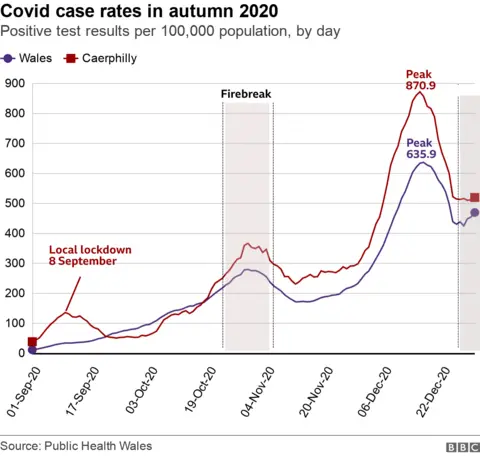
In the autumn of 2020, a series of local lockdowns - which began in Caerphilly in early September 2020 - were introduced to try to stop a rise in cases.
These eventually covered most local authority areas in Wales but only had a short term impact. This measure was followed by a Wales-wide "firebreak" lockdown on 23 October 2020. The case rate then rose to a second wave peak in winter 2020.
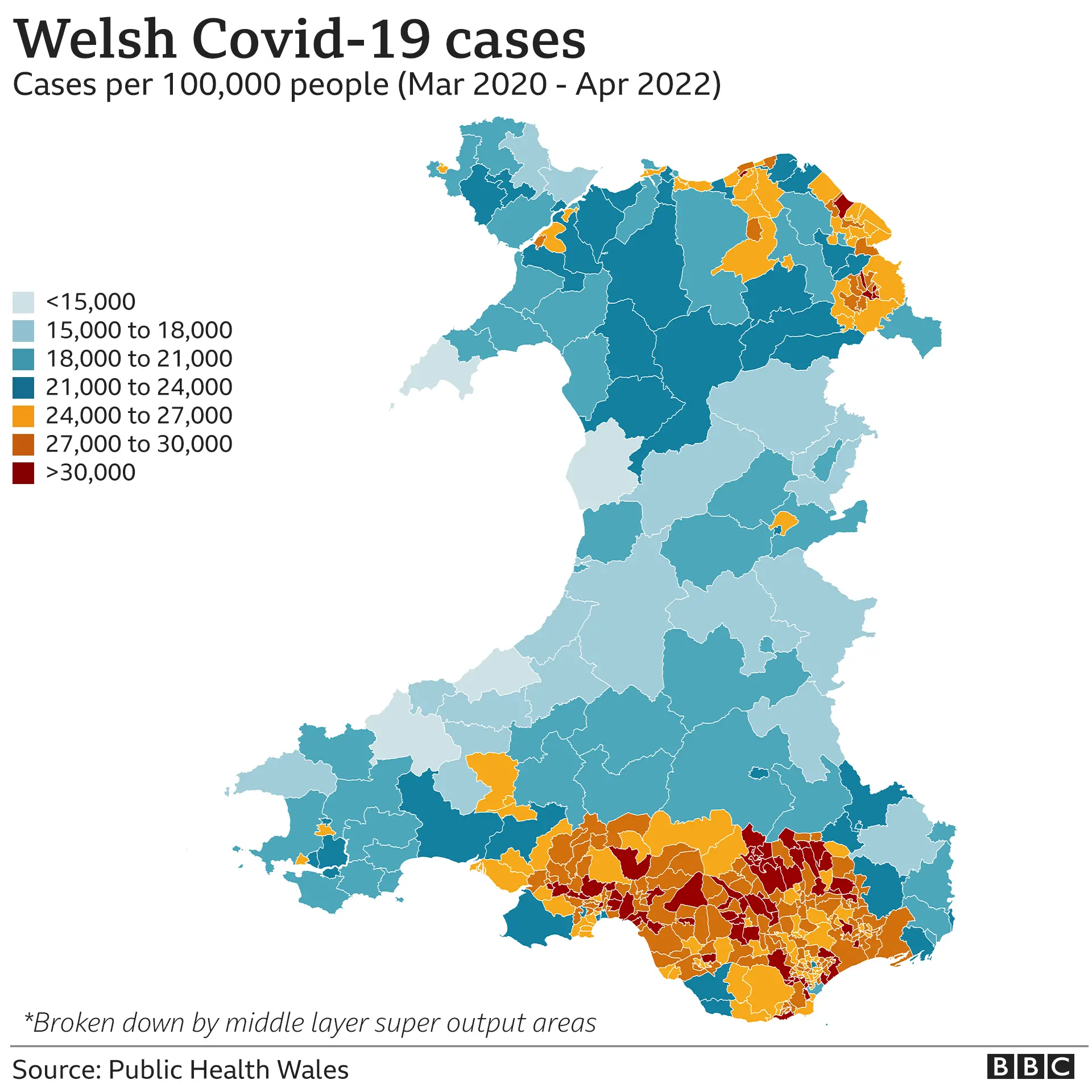
When we look at infections at a community level, there has generally a split between rural and more urban areas.
This is noticeable when we look at a map of community case rates for the whole pandemic, taking into account population sizes.
- Pontardawe in Neath Port Talbot - of similar-sized smaller communities - had the highest number of positive Covid tests, 3,796
- Tonypandy West and Clydach Vale in Rhondda Cynon Taf had the highest case rate of these smaller communities
- The lowest case rate was in Cilgerran and Crymych in Pembrokeshire
- Abersoch in Gwynedd is the community with the smallest number of positive tests, 839.
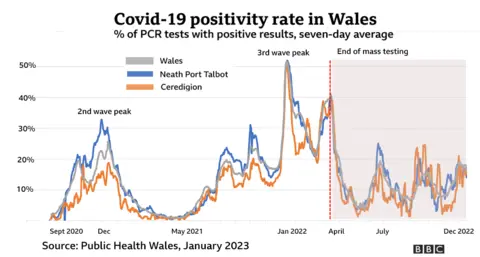

At the peak of the Omicron wave at the end of 2021, the positivity rate - the number of positive results from all PCR tests taken - reached 51.6%.
Locally, Neath Port Talbot over the course of the whole pandemic had the highest positivity rate (18.8%) and Ceredigion the lowest.
Earlier in the pandemic, a 5% positivity threshold was suggested by the World Health Organisation as an indicator that infections were too high.
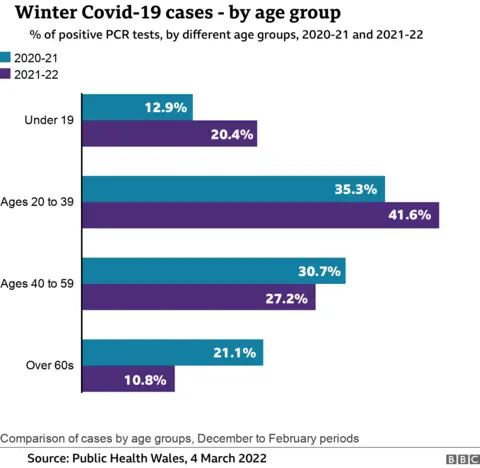

A younger profile for much of the third wave
There was a much younger profile to cases in the third wave in the latter half of 2021.
Between January and March 2022 there was a rise in proportions of those aged 20 to 40 testing positive.
In terms of PCR tests, the 20 to 40 age group made up more than 41% of positive results in winter 2021-22.
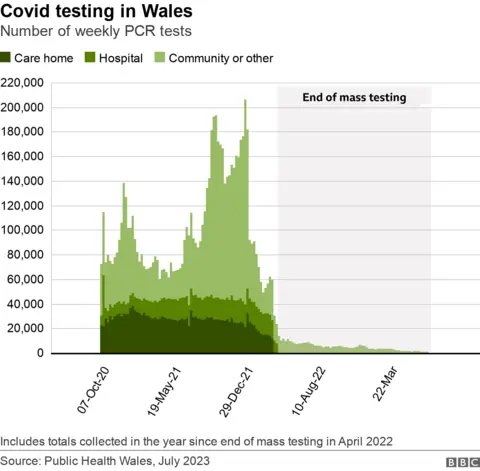

What do the figures on testing tell us?
Nearly 8.9 million Covid-19 tests have been carried out since the start of the pandemic, with the first positive result recorded in Swansea on 27 February 2020.
For most of the first wave, testing was confined to hospitals and some care homes but mass testing became available in the spring of 2020.
This ended at the start of April 2022, although it is still taking place in hospitals and also for some vulnerable people and those with symptoms in care homes.
There are around 2,500 PCR tests currently taking place each week, about half in the over 60s. This compares to around 200,000 a week at the pandemic's peak.
Up to the end of routine testing in April 2022, about 17,000 PCR tests routinely took place in hospitals each week and up to 30,000 weekly in care homes.
Testing that was processed privately - at so-called Lighthouse labs - is no longer taking place.
There have also now been changes to guidance for Covid testing in hospitals, although patients will still be tested before admission or ahead of surgery or chemotherapy.

Altogether, around 32,500 positive results were recorded in care homes over the course of the routine testing programme from autumn 2020.
Care home staff no longer need to take a weekly PCR test, while free lateral flow tests will only be provided in limited circumstances.

School absences for Covid-related reasons are no longer being recorded.
We saw over the 2021-22 academic year, 69.1% of pupils missed at least half a day's schooling because of Covid.
Absenteeism for any reason continued to rise, including those persistently absent.
The percentage of secondary school pupils who were persistently absent had tripled to 16.3% from 2018-19 - the last full academic year before Covid - and 2022-23.
This was more than twice the absence rate in pre-pandemic years.
Analysis of these figures showed 10% were persistently absent - and this rose to 21% of those from poorer backgrounds.

R-number no longer being used to measure infections
The so-called R-number - the reproduction number - had been a tool to express the infection rate of Covid.
However, it is has now been phased out as a measure.
Expressed within a range, if it was above 1, this indicated that infections were growing.
The range for the last estimate in December 2022 was between 0.9 and 1.2, suggesting infections were rising. So, for every 10 people with Covid in Wales, between another nine and 12 people would be infected.
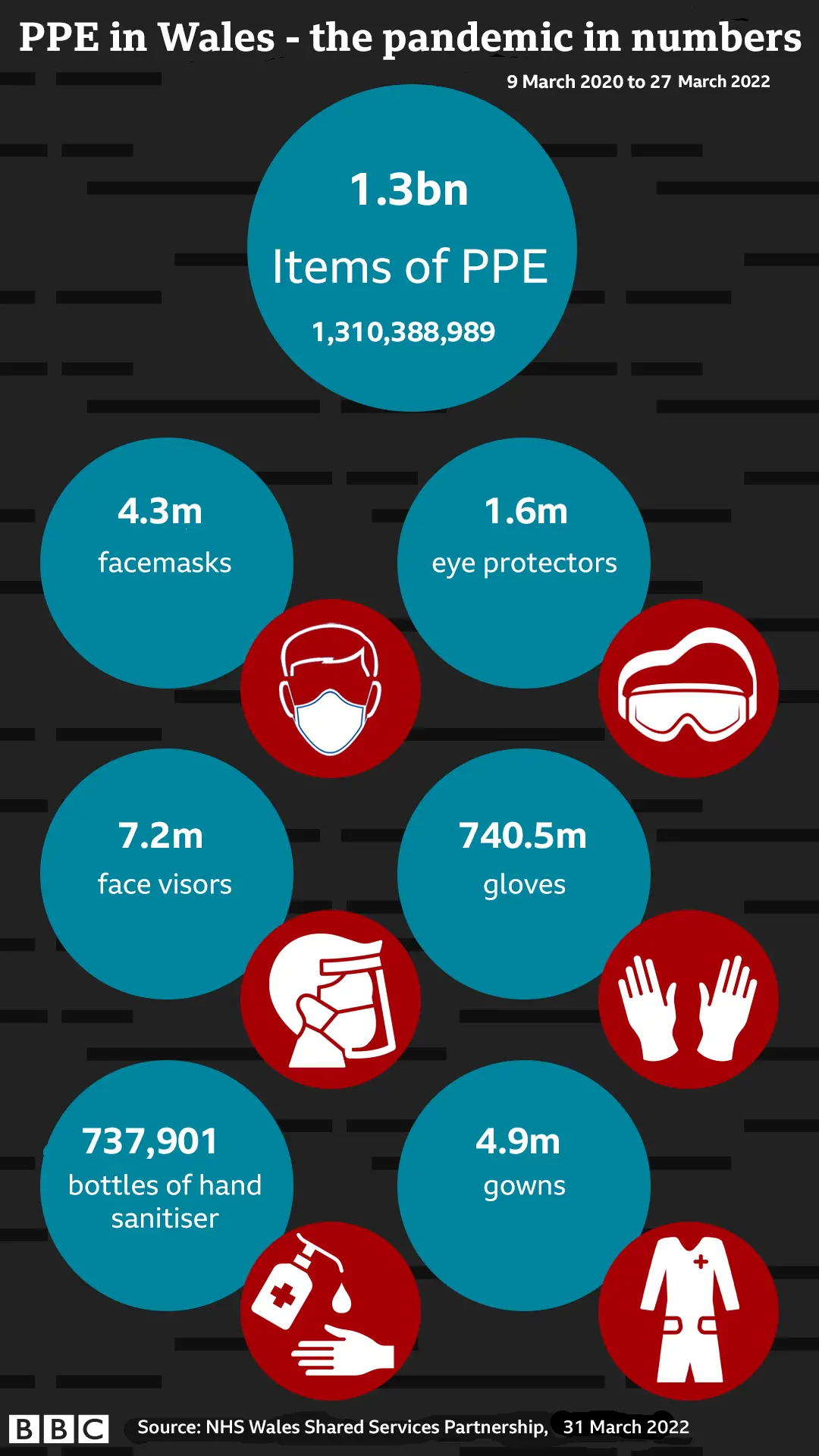
How much has Covid cost?
In the financial year ending in March 2021, the first year of the pandemic, spending on infectious diseases in the NHS in Wales jumped by £373 million.
That worked out at £156 per person in Wales, or just under 6% of all NHS Wales spending.
The costing of treating patients with Covid and managing the virus was put at £628m. Spending also included field hospitals and operating the track and trace system.


